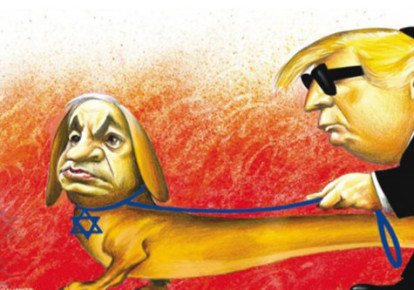How an anti-Semitic cartoon ended up in The New York Times

The demonstrators packed Eighth Avenue in New York City in response to a recent cartoon that was baldly anti-Semitic. The image appeared in international editions of The Times last Thursday. It called to mind “a very dark time in Jewish history,” lawyer Alan Dershowitz said at the protest. “I ask myself, how could it have happened?”That’s what staffers at The Times wanted to know too. In interviews this week, 16 Times staffers described a short-staffed international publication; an opinion section prone to self-inflicted wounds; and an ongoing debate about the newspaper’s biases and blind spots.They said the episode has prompted embarrassment inside the newspaper. But several staffers said they were impressed by a set of changes that Times publisher A.G. Sulzberger announced on Wednesday.Still, the discussions continue. Some of the paper’s critics say it has a deep-rooted cultural problem when it comes to Israel and anti-Semitism. Others reject that charge completely, saying the publication of the offensive cartoon was simply the result of an overworked editor.”I don’t think anyone in our office believes for one second there is an issue with institutionalized anti-semitism at the NYT,” one staffer in an international bureau said. “But as with all newsrooms that have gone through radical restructuring in recent years, that so many checks and balances have been removed and that this could go up without being seen by a second pair of eyes makes reporters and editors alike concerned.”Like most of the others interviewed for this story, the staffer insisted on anonymity to speak candidly about their employer.James Bennet, the editor in charge of the Opinion section, declined to be interviewed. But on Wednesday he published an editorial criticizing, in effect, his own department. “Apologies are important,” the editorial board said, “but the deeper obligation of The Times is to focus on leading through unblinking journalism and the clear editorial expression of its values.”Later in the day, Sulzberger spoke out about the cartoon for the first time. He wrote in an internal memo that “we are taking disciplinary steps” with the editor involved, and making a series of procedural changes to “ensure adequate oversight.” For one thing, there will be no more syndicated cartoons.”Our journalists work hard every day to help people understand a vast and diverse world and ensure prejudices of any kind do not make it into our report,” he said in the memo. “Though I’ve been assured there was no malice involved in this mistake, we fell far short of our standards and values in this case.”Those are much stronger words than the newspaper originally used to address the controversy. What went wrongPortuguese artist António Moreira Antunes has been drawing political cartoons for 45 years. He recently decided to take on the relationship between U.S. President Donald Trump and recently re-elected Israeli Prime Minister Benjamin Netanyahu.The result was an image of a Netanyahu as a dog on a leash, Star of David around his neck, held by a blind Trump wearing sunglasses and a yarmulke.Antunes told CNN that he does not believe the image evoked hateful anti-Jewish stereotypes in any way. But numerous journalists and activists said it was reminiscent of Nazi propaganda. Jonathan Greenblatt, the CEO of the Anti-Defamation League, said on CNN that the cartoon exhibited “stereotypes that suggest Jewish control.””It wouldn’t surprise me if this was published out of Tehran or Damascus, but it does not belong in The New York Times or any credible media outlet,” he said.Antunes’ cartoon was first printed by Expresso, a weekly newspaper in Lisbon. It reached The Times through a syndication service called CartoonArts International. For years The Times, in turn, has been carrying CartoonArts content on its own licensing site, distributing cartoons to other outlets.A production editor at The Times, charged with picking a cartoon to fill some space in Thursday’s international edition, looked through the newest options in CartoonArts’ collection, picked the one by Antunes, and moved on, two of the sources said. The cartoon — unrelated to the opinion pieces around it — appeared in Thursday’s paper in the version of The Times that is published outside the United States.The international edition has a valuable base of readers, but it is largely an after-thought at The Times’ headquarters in New York. It’s “not a high priority” is how one of the sources gently put it.Numerous staffers in New York said they didn’t know the international edition carried cartoons at all, since the domestic edition does not. So the outrage that was about to erupt was a surprise for several reasons.The cartoon did not get much attention on Thursday. According to The Times, senior editors did not even know about it. This appears to be a key failing — that there weren’t multiple eyes on the page before it went to the printing press. The international Opinion section reports up to Bennet.The Times declined to comment on why the page wasn’t reviewed ahead of time.According to the paper, the senior editors “learned of the cartoon on Friday,” and “immediately began drafting an editors’ note.”But the Times’ initial response didn’t convey much urgency. That may be because the international edition does not come out on the weekends — so the earliest the note could appear in print was Monday.The cartoon was removed from The Times’ licensing site on Friday, according to the newspaper. But The Times didn’t post the editors’ note on the web until Saturday morning, twelve hours after the paper began to be criticized on social media.The Times admitted in the initial editors’ note that the cartoon contained “anti-Semitic tropes,” was “offensive,” and was an “error of judgment.”Other news outlets went looking for the cartoon in question. It became a big story. Jewish organizations condemned The Times for allowing the cartoon to be published. Media critics questioned why The Times was being secretive. Members of Trump’s inner circle called out The Times and asked why the paper wasn’t apologizing for the misstep.Executives at The Times meant for the note to be an apology, according to a source who was involved. But it didn’t contain any apologetic language.”My sense is that management was caught unaware of how big a deal the cartoon was to the people who were offended,” a Times staffer said.The executives started working on a second statement, one that had an explicit apology and a partial explanation of what happened. That didn’t come out until Sunday afternoon.And the criticism kept coming. On Monday, Trump weighed in on the cartoon and complained that The Times hasn’t apologized to him for “fake and corrupt news.””Self-inflicted wounds” At most newspapers, including The Times, there is a firm divide between the newsroom and the Opinion department. Staffers sometimes move from one to the other, and friendships span the divide, but they operate autonomously. And they sometimes get in each other’s way.Newsroom staffers who spoke with CNN Business said they were shocked when they found out about the cartoon. But some of them pointed out past controversies from the Opinion section, suggesting a series of self-inflicted wounds.One day early last year, the department announced the hiring of Quinn Norton to be the editorial board’s “lead opinion writer on technology,” then dropped her by the end of the same day, citing offensive social media posts in her past. Bennet said he was not aware of the slurs and other content on Norton’s Twitter feed until people outside The Times started tweeting about it.Six months later the department published an animated short that showed Trump and Vladimir Putin as lovers, stirring accusations of homophobia.”Several LGBTQ employees of The Times saw the video as a sign of disrespect and homophobia,” The Times staff union’s diversity committee said in a letter.The leadership of The Times evidently disagreed, and the animation remains online. The overall project recently won a Webby Award.”Between the homophobic Trump-Putin cartoon and the anti-Semitic material they published this weekend it does seem like they keep shooting themselves in the foot,” a Times reporter said, describing these as “self-inflicted wounds.”But for all of Bennet’s critics, even internally, he also has many supporters. He is a close ally of A.G. Sulzberger, the newspaper’s publisher, who took the reins from his father at the end of 2017.A staffer who is supportive of Bennet credited him and his team with “trying to diversify the range of contributors in a deeply polarized environment.” A “pattern” or a publication stretched too thin?The cartoon became the latest flash-point in a long-running fight over The Times’ coverage of Israel. Anti-semites have long derided it as a “Jewish newspaper,” citing the religious roots of its family owners. And critics of The Times, primarily on the right, have long accused the paper of hostility toward Jews.At Monday’s protest, Dershowitz said The Times “has been wrong so often when it comes to Israel, when it comes to the Jewish people — the only good thing The New York Times has ever done for the Jewish people is that it put a lie to the notion that the Jews control the media and use it to support their own interests.”Conservatives say that progressive institutions, like the Opinion section of The Times, have gone easy on left-wing manifestations of Jew hatred.Some readers “see a pattern,” one of the Times staffers said. “The pattern is being so receptive or encouraging of criticism of Israel, particularly criticism of the current Israeli government, that the criticism bleeds into anti-Semitism or renders you blind to anti-Semitism.” Wednesday’s editorial addressed this: “We have been and remain stalwart supporters of Israel, and believe that good-faith criticism should work to strengthen it over the long term by helping itstay true to its democratic values.”Bret Stephens, a conservative op-ed columnist for The Times, took on the issue in a blunt column about the cartoon in Monday’s Times.He said the paper as an institution is not in any way anti-Semitic, but needs to reflect on how the paper is perceived and why the cartoon was allowed in print.He asked: “How have even the most blatant expressions of anti-Semitism become almost undetectable to editors who think it’s part of their job to stand up to bigotry?”The column has received more than a million page views since Sunday, a very high total for any op-ed, one of the staffers said.On Tuesday Stephens told CNN Business that Bennet did not hesitate to publish the column, and that few changes were made to the draft aside from copy edits.Bennet’s willingness to allow for such self-criticism reflects well on the paper, Stephens said.Self-criticism, yes, but others faulted the paper for not providing more information. The Times eliminated its in-house public editor position two years ago. The public editor office was responsible for fielding readers’ complaints and getting answers from the paper.Sunday’s apology statement said “a single editor” picked the cartoon “because of a faulty process.” The Times declined to name the person. Most of the sources who spoke with CNN said they do not know who picked the image. The others said they did not want to identify the person, because they believe the matter should be handled internally. “This isn’t about a person, it’s about an institution,” one of the staffers said.And about a lack of checks and balances.”You would never have one mid-level editor publishing something in the news report with no oversight from anyone,” one of the Times reporters observed.Some of the people who put out the international edition feel that they’re stretched too thin — an all-too-common feeling in newsrooms these days. But heavy work loads can’t be an excuse for this type of error, other Times journalists said.”We need multiple sets of eyes on everything,” said one.Sulzberger acknowledged this in Wednesday’s memo. He said, “We are changing our production processes to ensure adequate oversight and address issues with the international Opinion pages that enabled this mistake.”In addition, he said, “We have stopped running all syndicated cartoons, which are created by those with no direct ties to The Times and thus give us limited editorial control.” And the contract with the CartoonArts syndication service has been “cancelled,” he said. Cartoonist weighs inThe editorial board of The Times said the editor who picked the cartoon “did not recognize its anti-Semitism.” The board implicitly criticized the person, calling the publication of the cartoon “evidence of a profound danger — not only of anti-Semitism but of numbness to its creep.”And Sulzberger said that the newspaper is “updating our unconscious bias training to ensure it includes a direct focus on anti-Semitism.”In response, a staffer said he expected “there will be some grousing” about the training, since “this was one production editor.”All the while, the cartoonist at the center of it all said he had no anti-Semitic intent and only drew the cartoon as a political statement.In an interview with CNN, conducted in Portuguese, Antunes said he was surprised by the outrage. He said he has the “utmost respect” for the Jewish peoples’ past, but said that doesn’t mean they can be “above criticism.”He claimed that anti-Semitism charges are a misunderstanding “made through the Jewish propaganda machine, which is, anytime there’s criticism it’s because there’s someone anti-Semitic on the other side, and that’s not the case.”He blamed right-wing figures: “The Jewish right doesn’t want to be criticized, and therefore, when criticized they say ‘We are a persecuted people, we suffered a lot… this is anti-Semitism.'”Antunes also said he was hurt by the Times’ statements. “They should see that here it’s a political issue and not religious,” he said, adding that people should not accept the idea that “any criticism of Israel is anti-Semitism.”The Times made its own determination that the cartoon was anti-Semitic — well after it was published in the international edition. On Wednesday, Sulzberger reiterated the paper’s Sunday statement, which said “this imagery is always dangerous and has grown more so at a moment when anti-Semitism is on the rise around the world.”And, the publisher said, “We also committed to making changes to prevent something like this from happening again.”Update: This story has been updated to more accurately describe Expresso.CNN’s Duarte Mendonça contributed reporting.





